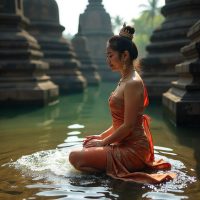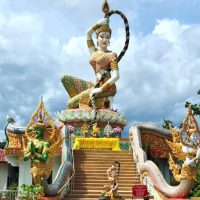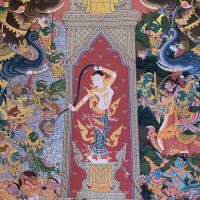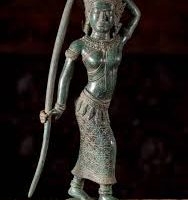Phra Mae Thorani : The Earth Goddess of Southeast Asia
Listen
At a glance
| Description | |
|---|---|
| Origin | Laotian Mythology |
| Classification | Gods |
| Family Members | N/A |
| Region | Laos, Thailand |
| Associated With | Earth, Buddha |
Phra Mae Thorani
Introduction
Phra Mae Thorani stands as one of the most enduring symbols of virtue, protection, and cosmic justice in Southeast Asian Buddhist traditions. Revered across Thailand, Laos, Cambodia, and Myanmar, she embodies the Earth itself—steadfast, nurturing, and eternally witnessing the moral actions of sentient beings. In Thai and Lao Buddhism, her presence becomes especially significant during the Buddha’s enlightenment, where she emerges not as a passive element of nature, but as an active divine force affirming truth and dispelling illusion. Known in Laos as Nang Thorani and in Myanmar as Wathondara, her myth bridges cultures while preserving a unified narrative: she is the Earth Goddess who validates righteousness by bearing witness to Siddhartha Gautama’s accumulated merit. Her intervention in the enlightenment story made her a guardian deity of truth, perseverance, and moral clarity, and her symbolism continues to inspire devotion throughout Southeast Asia.
Physical Traits
Phra Mae Thorani is most recognisable in her iconic imagery: a youthful woman with a serene expression and long, flowing black hair. This hair is more than aesthetic beauty—it becomes the conduit for divine action. In the enlightenment narrative, she wrings her hair, releasing vast torrents of water formed from the Buddha’s countless acts of merit. This flood becomes the force that overwhelms Mara’s armies, affirming the supremacy of virtue over temptation. Artistic depictions across regions maintain her graceful posture, often showing her kneeling with one hand touching the ground or bending forward as she wrings her hair. Whether carved in stone, painted in murals, or represented in bronze, her expressions radiate calm strength, embodying both compassion and unwavering resolve. Traditional Thai, Lao, or Khmer garments and delicate jewelry further root her visual identity in the cultural aesthetics of Southeast Asia.
Family
Unlike many deities in regional mythologies, Phra Mae Thorani is not defined by familial relationships. Buddhist texts describe her as an elemental being rather than a figure born from a divine lineage. She is Mother Earth—primordial, independent, and timeless. Her presence predates human structures of kinship, making her role universal rather than genealogical. As the Earth itself, she is metaphorically connected to all beings who live upon her surface and partake in her sustenance. Her profound bond with the Buddha is not one of blood but of cosmic truth: she bears witness to his virtue and rises in his defense when the forces of illusion attempt to deny his accumulated merit. In this way, her relationship to humanity is maternal and inclusive, grounded in nurturing, protection, and moral support.
Other names
Phra Mae Thorani’s significance across Southeast Asia has led to several regional names, each reflecting linguistic tradition while retaining her core identity. In Thailand, she is widely known as Phra Mae Thorani, combining the honorific Phra, meaning “venerable,” with Mae, meaning “mother.” In Laos, she is addressed as Nang Thorani or Mae Thorani, maintaining her maternal status. In Khmer traditions, she appears as Preah Thorani or Neang Kongheng, while Burmese Buddhists know her as Wathondara or Wathondare, names derived from the Pali term Vasudhara, meaning “earth-bearer.” Despite these variations, all titles highlight her essence as the embodiment of the Earth and the divine feminine presence that upholds truth and virtue.
Powers and Abilities
Phra Mae Thorani’s most celebrated ability is her power to manifest the accumulated merit of the Buddha in the form of purifying waters. During the critical moment of Siddhartha Gautama’s meditation, Mara challenges his right to attain enlightenment by claiming there is no witness to his acts of virtue. When the Buddha touches the ground, Phra Mae Thorani emerges and wrings her hair, releasing torrents of water formed by his meritorious deeds. This flood becomes the protective force that sweeps away deception, corruption, and obstruction, clearing the path to enlightenment. Her power is not destruction but purification—a cleansing of negativity through the evidence of virtue. Beyond this foundational myth, she is regarded as a goddess of fertility, grounding, moral witness, and the sustenance offered by the Earth. Her presence reassures devotees that righteousness is always supported, even in moments of greatest trial.
Modern Day Influence
In contemporary Thai and Lao culture, Phra Mae Thorani remains a deeply respected figure whose symbolism extends far beyond temple walls. Her image frequently appears at the base of Buddha statues, signifying her role as the foundation of spiritual practice. Temples, parks, government buildings, and public sculptures often portray her in her iconic hair-wringing posture, reinforcing her image as the Earth’s guardian. She is also widely used as an emblem of environmental ethics: her association with water, purity, and the Earth resonates strongly with modern conservation movements. Thai environmental groups invoke her symbolism to promote water preservation, sustainable agriculture, and ecological responsibility. In addition, she represents moral integrity, female empowerment, and resilience. Tourist guides, cultural educators, and artists continue to draw upon her story, ensuring her ongoing relevance in both religious and cultural spheres. Through her enduring presence, Phra Mae Thorani continues to embody the inseparable relationship between humanity and the Earth.
Related Images
Source
Fabulahub. (2025, October 20). Phra Mae Thorani: Thai Earth Goddess who drowned Mara. https://fabulahub.com/en/story/the-story-of-phra-mae-thorani/sid-2597
Tibetan Buddhist Encyclopedia. (n.d.). Phra Mae Thorani. https://www.tibetanbuddhistencyclopedia.com/en/index.php/Phra_Mae_Thorani
Wikipedia contributors. (2011, January 15). Phra Mae Thorani. Wikipedia. https://en.wikipedia.org/wiki/Phra_Mae_Thorani
Pattaya Unlimited. (2018, December 12). Mae Thorani aka Earth Goddess. https://www.pattayaunlimited.com/mae-thorani-aka-earth-goddess/
Incantation In Kamulets. (2022, September 5). Mae Thorani (Mother Earth). https://incantationinkamulets.com/blogs/news/mae-thorani-mother-earth
Harris, I. (n.d.). Cambodian Buddhism, History And Practice [PDF]. https://asc.mcu.ac.th/database/wp-content/uploads/2018/06/Cambodian-Buddhism-History-And-Practice_Harris.pdf
Swearer, D. K. (1995). The Buddhist World of Southeast Asia. Albany: State University of New York Press.
Terwiel, B. J. (2012). Monks and Magic: Revisiting a Classic Study of Religious Ceremonies in Thailand. Copenhagen: NIAS Press.
Keyes, C. F. (1977). The Golden Peninsula: Culture and Adaptation in Mainland Southeast Asia. New York: Macmillan.
Reynolds, F. E., & Reynolds, M. (1982). Three Worlds According to King Ruang: A Thai Buddhist Cosmology. Berkeley: University of California Press.
Tambiah, S. J. (1970). Buddhism and the Spirit Cults in North-East Thailand. Cambridge: Cambridge University Press.
Frequently Asked Questions
Who is Phra Mae Thorani in Buddhism?
Phra Mae Thorani is the Earth Goddess in Thai, Lao, Khmer, and Burmese Buddhism, known for witnessing the Buddha’s merit and helping defeat Mara during his enlightenment.
Why does Phra Mae Thorani wring her hair?
She wrings her hair to release waters formed from the Buddha’s accumulated merit, creating a flood that washes away Mara’s armies.
Is Phra Mae Thorani a Hindu goddess?
No. Though her name has roots in Pali and Sanskrit, Phra Mae Thorani is primarily a Buddhist Earth Goddess in Southeast Asian traditions.
What does Phra Mae Thorani symbolize?
She represents truth, purity, fertility, protection of the righteous, grounding energy, and the moral witness of the Earth.
Where can you find images of Phra Mae Thorani today?
Her statues and murals appear in temples across Thailand, Laos, Cambodia, and Myanmar, as well as in public parks, cultural centers, and environmental symbols.









